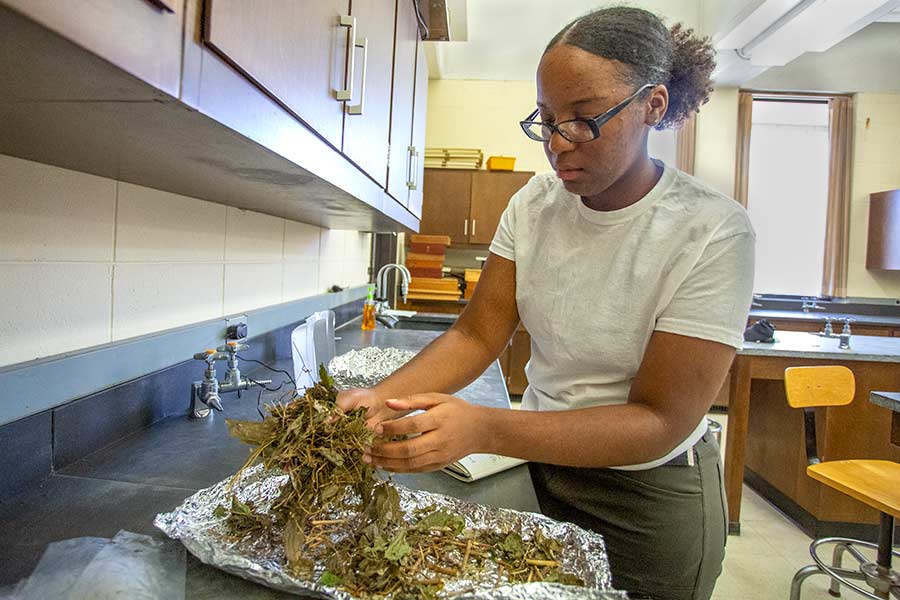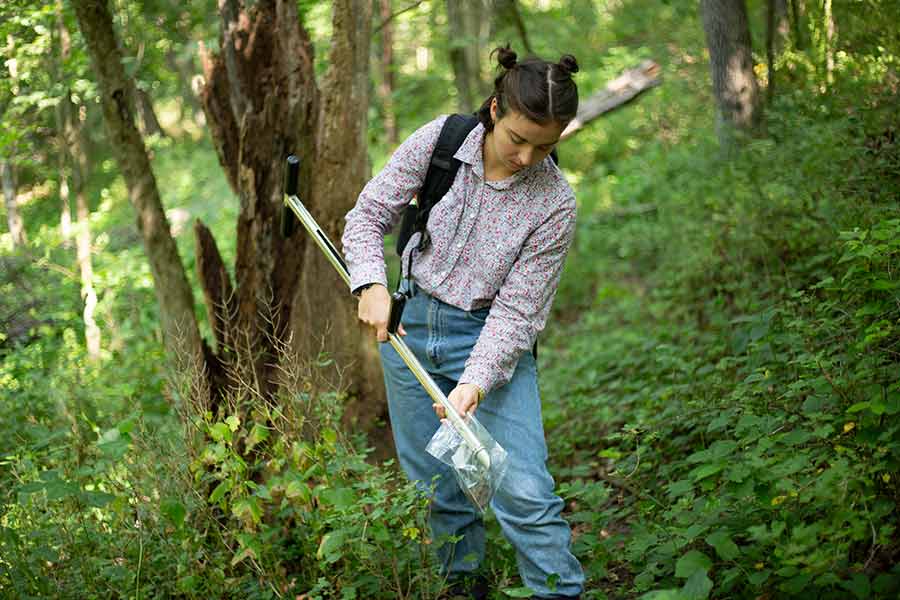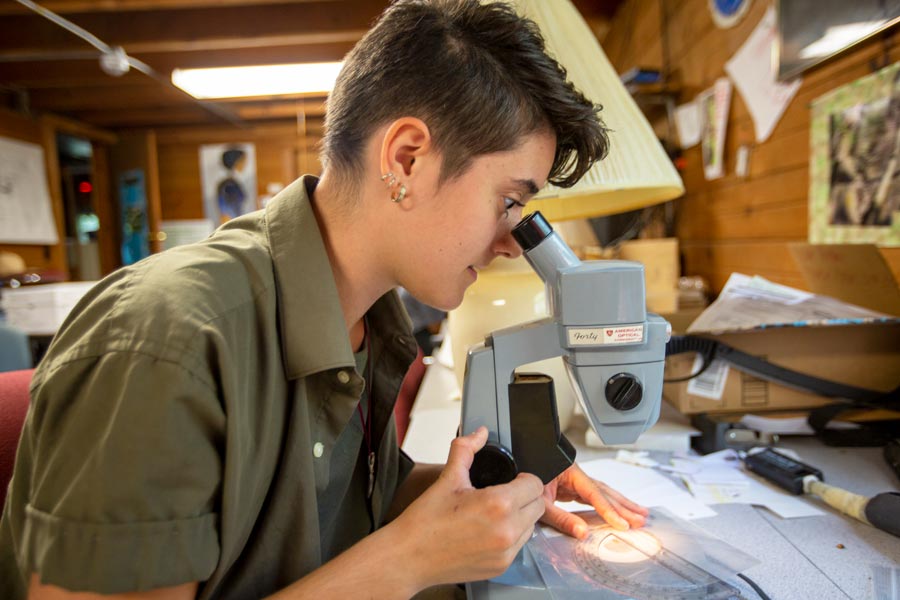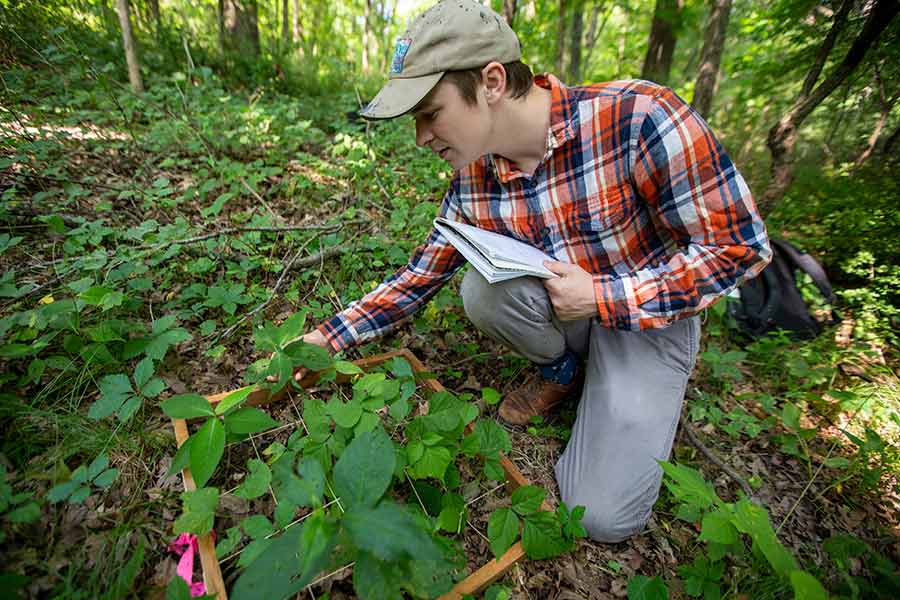Andie Carlson-Dakes '20 conducts a survey of bees in a field at Green Oaks. Photo by Steve Davis
While Knox has no shortage of opportunities to offer at its campus in downtown Galesburg, there is a part of the College that lies 20 east of campus that has become, for many, a deeply valued part of the Knox experience.
Green Oaks Biological Field Station is a site for learning and community building in various forms—from the 10-week interdisciplinary Green Oaks Term to the annual Prairie Burn. Created more than 50 years ago on land previously used for farming and mining, the site is now home to the region's second-oldest prairie restoration project.

Lydia Allen was one of four seniors who had the opportunity to conduct research while being surrounded by the 700 acres of forests, grasslands, and aquatic habitats at Green Oaks. The students were selected and awarded stipends for their summer research projects by the biology department.
Allen’s project, a comparative study, investigated the differences in organic carbon levels across several prairie fields, forests, spoil banks, lost meadows, and creek banks at Green Oaks. Eventually, she would like to explore how positive conservation efforts impact human health.
“The land has been owned by Knox for years, but before that some areas were farmed and strip mined, so I want to see how the organic carbon level changes across different ecosystems and historical land uses,” said Allen, who is a biology and public health double major. “It’s important to be aware of how well soil holds carbon because it could inform future prairie restorations, which is important in the face of climate change.”
Her favorite part of the project was being able to live at Green Oaks. “This experience definitely taught me that I could live somewhere very secluded and be happy, and that I enjoy working outdoors. It actually became a very meditative experience to go out and collect samples.”

To Andie Carlson-Dakes, seeing animals scurry around in their natural habitat was nothing short of fascinating. She added that because of her interest in natural history, Green Oaks has had a lot to offer her—including Green Oaks Term and a bat research project at the site last summer.
“Through all my time at Green Oaks, I have learned a lot about the natural history of the region and seen a lot of different animals and plants,” she said. “Several times this summer and last summer, I have seen either an individual or a family of minks crossing the road. I have also seen many baby raccoons and deer, and last year I also saw a turtle laying eggs!”

Carlson-Dakes received the Burney Dunn scholarship to fund a survey of bees that pollinate different flowers. “I will be analyzing the data to see if certain types of bees have a preference for specific flower characteristics and to see what flowers might have specialized pollination.”
Ben Dolezal and Tresa James, who did research on invasive and non-native species of plants at Green Oaks, were more captivated by the surrounding green landscapes. Dolezal said that “it was most exciting to watch different wildflowers bloom throughout the summer, and watch the prairies grow.”
Having conducted several surveys of trees and shrubs during Green Oaks Term in 2018, Dolezal had become familiar with the different non-native species in the forest and had seen how widespread many of them were.
“Now, I'm looking at how invasive shrubs are affecting plant growth in the forest, and seeing which ones have a more harmful effect on the plants growing around them,” he said, hoping to use this study as a start to his senior research and Honors project.

Dolezal added that the experience should be useful as he plans to pursue plant science in graduate school. “It has helped me learn a lot more about forest structure and plant growth, and has made me become more comfortable with field identification.”
With guidance from Associate Professor of Biology Jim Mountjoy and a plant physiology class she took last year, James found her interest in invasive species and the potentially harmful characteristics they may exhibit. Her research investigates the allelopathic relationship between invasive species and native plants at Green Oaks.
“Being surrounded by nature and researching about something I am extremely passionate about has been incredible.” she said. “The plant sciences has always intrigued me, and I am utterly grateful that I was given the opportunity to freely explore and learn about an area of passion of mine at Green Oaks.”